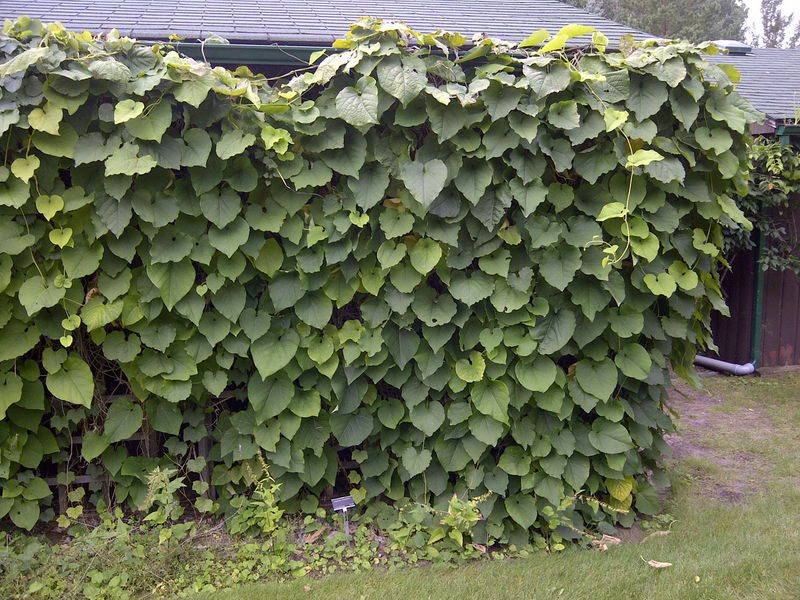Pipe vine plant is a great addition to any garden. They add texture and color, but they can also be hard to grow if you don’t know what you’re doing. Pipe vines should be planted in early summer because they bloom in early spring.The plant type is generally vine.
This article will teach you everything you need to know about growing pipe vines in your backyard or on your balcony. You’ll learn the best ways of growing and caring for them so that they thrive and produce beautiful flowers every year.
How to Care for Dutchman’s Pipe Vine
Pipe vine, Dutchman’s pipe or formerly Aristolochia durior, is a perennial plant that has big heart-shaped leaves and resembles wild ginger. It is in the birthwort family, and the scientific name is Aristolochia macrophylla. It’s also known as green pipe vine or green Dutchman’s pipe.

Image credit: https://www.thespruce.com/
It has large leaves with smooth texture and heart-shaped. The leaf color includes dark green, deep green and pale silver while flower color is green, purple and yellow.
Pipe vine is a hardy plant that produces interesting flowers that resemble Dutch smoking pipes. The structure flower also resembles the human fetus. While the dense foliage often hides their flowers, they’re truly a unique feature. This easy to grow plant requires few elements such as sunlight and well-draining soil to grow with their vibrant green foliage and full vines.
Follow these other care tips to keep your pipe vine healthy and happy.
Light
Pipe vines prefer partial shade and direct sunlight only part of the day. If the plant doesn’t get enough sun, it will be weak and may not flower. Dutchman’s pipe vine needs four to six hours of full or partial sunlight every day to thrive. If you can provide it with full sun, it will achieve the best growth and flowering potential.
However, this Dutchman’s pipe is a hardy outdoor plant that can tolerate varieties of climate, including areas experiencing harsh winters. While you can plant it in the shade, full sun helps to bring out the beauty of its large leaves into the heart-shaped.
Soil and Transplanting
The Dutchman’s pipe vine doesn’t require any particular soil to thrive. All it needs is moist and well-drained soil, which is why it grows well near woodlands, creeks, or swamps.It also needs space to grow and not disrupt other plants, so plant it 1 to 2.5 meters away from other plants.
If you want to grow the plant in your garden, mix organic composts to loosen up the soil and help drain any water that accumulates during heavy rains. Or else, the stems will rot because of too much standing water where its roots are planted. Testing soil pH is not important to pipe vines because it can thrive in neutral and acidic mixtures.
If you’re looking for large, robust leaves, then rich, nutrient-filled soil is what you need. It’s best to use a blend of cow and horse manure to enrich the soil and add in some clay for drainage purposes. There’s no need for transplanting because Dutchman’s pipe vine is a large climbing vine that you should grow next to a structure where the foliage can start climbing.
Watering and Feeding Pipe Vine
This plant doesn’t need watering more often. But in dry regions and locations experiencing a dry spell, make sure to water the plant at least once a week and for best results. You can also fertilize this plant with a standard liquid fertilizer to help the plant grow faster.
Use the fertilizer two to three times during the spring and summer periods. When watering, aim at the hose of the base and not directly at the dense foliage because this can cause fungal problems.
Size and Growth Rate
Dutchman’s pipe vine plant can grow up to 20 feet in height and be readily available at your local nursery. In good conditions, its heart-shaped leaves can reach up to 12 inches a year. It’s recommended for USDA zones 4 to 8. Its clinging vines grow quickly to produce broad leaves that create a dense cover.
The leaves are shed in the winter and come back in the early spring. By the early summer, you should be able to see a dense, lush wall of leaves.
Temperature and Humidity
If the temperature starts dropping, it’s important to add mulch around its roots to insulate them against cold weather. If you want to plant pipe vine outdoors, remember that it’s not frost hardy, so it must be brought indoors during the winter months.
The plant prefers high humidity and moderate water conditions throughout the year and with good drainage as well. It needs less watering if you live in a warmer climate. Pipe vines will not grow well without humidity, so you might have to mist them now and then if the room is very dry. If the leaves start to turn brown or yellow at the tips, then it’s getting too much water.
Pruning
Pipe vines are not very picky about pruning. You can trim them back anytime to keep them healthy and growing fast or keep them in a vase shape for decoration. Prune them to keep them tidy all the time. Regular pruning also promotes more flowers.

Image credit: https://www.gardeningknowhow.com/
Make sure you look for the weakest branches and any branches that are getting out of hand, then prune them off. Pruning should always be done in late winter or early spring.
How to Propagate Aristolochia Vine
Leaf cuttings, which are from large leaves from healthy plants, can be used as propagation material. The best time to take cuttings is in the spring when the vine is thriving. When taking stem cuttings, make sure your cutting has some leaves to have the energy to grow new roots.
Dutchman’s pipe is one of the easiest plants to propagate from seed. Using this method will ensure that you have a different variety than that which you started with. You can also maintain the desired size of this plant by cutting back excessively long stems.
ristolochia Macrophylla Common Pests and Diseases
Dutchman’s pipe plant doesn’t have any major disease problems and pests. It can quickly outgrow any small infestation of insects or diseases. Because this is a climbing vine, it does need to be treated for any major spider mite infestations in the summer months.
It can grow quickly and reach 40 feet because it can be an invasive species in some regions. So, make sure you check with the local nursery to determine if the plant is off-limits. The plant is also a host to pipevine swallowtail butterfly larvae. The genus of this plant contains a toxin called aristolochic acid which is poisonous. But Pipevine Swallowtail Butterfly is immune to this poison.
Uses of Aristolochia Macrophylla
Aristolochia macrophylla is used for ornamental purposes. It is grown in gardens and indoors as well. You can also plant Dutchman’s pipe near a trellis, fences, and any other outdoor structure. Pipe vine can also be used to cover old, dead trees.

Image credit: https://prairiegardens.org/
Dutchman’s pipe around the dead tree allows the climbing vine to climb up the dead tree and cover it. This will eventually help a new tree grow from a seed in the dead trunk.
FAQs on How to Grow Pipe Vines
Is the Dutchman’s pipe a perennial?
Yes, it’s a perennial vine with heart-shaped leaves and blossom leaves. It has flowers that look like small pipes and produce seeds that you can use to grow new plants.
How long does it take to grow a Dutchman’s pipe?
It will take about two weeks for the vine to grow and cover the fence, tree, or trellis. The flowers might not make seeds in less than 100 days of cold weather. It requires an environment with cold temperatures.
Final Thought on How to Grow Aristolochia Vine
As you can see, growing and caring for pipe vines is not very difficult. Once it starts to grow, this perennial will cover the surface of whatever structure or trellis you put it on. There are so many uses for pipe vines, but they are best used as chain link fence.
The post How to Grow Pipe Vines appeared first on Kitchen Infinity.